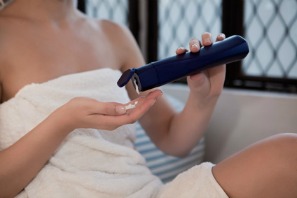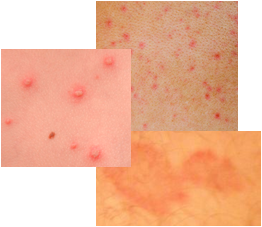Dry Skin Treatments
Visit this
PICTURES OF RASHES PAGE
Dry skin treatments are really composed of a four-pronged approach. First, you must avoid the dry skin causes or in other words avoid the factors that make the skin become dry. Second, dry skin prevention is critical as well. Take the necessary steps to avoid dry skin from becoming your problem. Being aware of the causes of dry skin and practising dry skin prevention are important dry skin treatments even if you already have dry skin, because this condition can get much worse than it already is.
The third factor in the dry skin treatment is seeking the advice from your family doctor who may refer you to a dermatologist. When should you seek the advice of a dermatologist? It is always better to be safe than sorry, especially when symptoms seem to be more problematic than just minor irritation. If you are concerned, make an appointment to discuss your dry skin problem.
The fourth factor in dry skin treatments is the use of a moisturizer. The use of a proper moisturizer (in combination with causes/prevention awareness) is an important element in dry skin treatment.
Moisturizers – A Closer Look
Before thinking about applying a moisturizer to your dry skin, the first step is to exfoliate it in order to have an effective dry skin treatment. Exfoliate means to shed or flake off dead tissue. This is a very important treatment because dead skin cells can accumulate, creating a barrier, and making the skin unresponsive to moisturizers. Moisturizers simply cannot penetrate properly to do the job they are supposed to do in this situation.

The role of moisturizers in dry skin treatments is to keep moisture in the skin or reduce the water loss from the skin by coating it with a protective barrier. At the same time, a moisturizer should avoid irritating the skin and should soothe it. Moisturizers are not about giving the skin moisture, they are all about keeping moisture in! However, too much moisturizer is not necessarily good for the skin and can actually lead to problems such as:
- clogging of pores which can cause acne
- inability for the dead skin cells to leave the skin surface, eventually leading to the skin becoming irritated
However, if your skin is dry, it is a good idea to apply a moisturizer as a proper skin care treatment for dry skin. A moisturizer should be used after bathing, showering, or cleaning of hands and face and before being exposed to harsh environments – such as a cold windy day. A moisturizer is best applied when the skin is damp.
Moisturizers Come in Several Forms
Ointments
- mixtures of water in oil (either lanolin or petrolatum)
- very effective in preventing moisture from escaping the skin
- thick and very greasy and are used more at bedtime than during the day
Creams
- oil in water mixtures
- greasy feel, but less than an ointment
- need to be applied more often than ointments to get similar effectiveness
- cleansing creams are available which clean (moderately) and leave behind a barrier to moisture loss
- barrier creams are thicker and tend to be used by people who need to have their hands frequently in water
Lotions
- powder crystals dissolved in water (water is the greatest component in a lotion)
- usually leave the skin feeling cool
- non-greasy feel after use
- easier to use because lotions absorb quickly
- do not have the same protective effect as ointments or creams and more frequent use is necessary
- cleansing lotions are good because they leave behind moisturizers, but their cleaning ability is limited
- for both cleansing creams and lotions, a mild moisturizing soap may be a better option when proper cleaning is a concern
Vist the moisturizer page for information on an effective treatment for dry skin.
Information on a soothing product specific for the hands and feet can be found at the lotion page.
Common Additives in Moisturizers
Many moisturizers have a long ingredient list. This is not necessarily a bad thing as each ingredient plays a specific role. Listed below are some common additives to help you understand the ingredient list for moisturizers. Take note of the ingredients that make for an effective dry skin treatment.
Humectants
- draw moisture from the air and bring it to the skin’s surface to aid in the treatment of dry skin
- much more effective in humid climates due to greater moisture available in the air
- can contain: glycerin, propylene glycol, urea, hyaluronic acid, glycolic acid, lactic acid, malic acid, sodium PCA, panthenol, honey
Vitamin A
- retinal or retinyl palmitate are forms of vitamin A that the skin converts to retinoic acid
- retinoic acid keeps skin pores clean and has been shown to improve sun-damaged skin
Exfoliating Agents in Dry Skin Treatments
- helps skin cells exfoliate (removal of dead skin cells from the surface of the skin)
- examples are alpha hydroxy acids (e.g. lactic acid, glycolic), urea, allantoin
Antioxidants
- vitamins C and E are commonly used to fight free radical oxidation of the skin
- protect (and repair to some degree) the skin from oxidative pollutants in the atmosphere and those harmful UV rays
- other examples of antioxidants are alpha lipoic acid, beta-glucan, curcumin, grape seed extract, green tea, soybean sterols, superoxide, dismutase, vitamin A
TIP
Packaging is important when it comes to moisturizer products. Antioxidants deteriorate rapidly when exposed to air and sunlight. If this occurs, your moisturizer will lose some of its effectiveness as a treatment. Therefore, make sure the jar or bottle is opaque and has a small opening. Wide mouth jars are not recommended.
Soothing Agents or Anti-Irritants
- helps your skin deal with some of the other ingredients in moisturizers that may cause irritation
- examples are bisabolol, allantoin, burdock root, aloe, licorice root, glycyrrhetinic acid, green tea, chamomile extract, grape extract, vitamin C, white willow, willow bark, willow herb
Binding Agents
- prevent the oil/water mixtures from separating out
Solvents
- such as alcohol may be present to help dissolve some of the ingredients into the moisturizer mixture
Preservatives
- kill and prevent bacterial growth in the product
Surfactants
- make application of the moisturizer easier by allowing it to glide smoothly onto the skin allowing for an effective dry skin treatment
Lipids and Ceramides
- fatty acids used to help restore natural lipids (fats) missing from the skin
Emollients as Dry Skin Treatments
- act to fill in spaces between skin cells on the surface of the skin
- soften and smooth the skin surface
- are a mixture of a small amount of water in oil
- examples are petrolatum, mineral oil, natural plant oils, shea and cocoa butter, cholesterol, silicones or animal oils (emu, mink and lanolin), certain non-drying alcohols such as cetyl, stearyl, octyl, aleyl and hexyl, ester compounds such as octyl stearate, isopropyl myristate, oleyloleate, and cetearyl isononanoate
Dry Skin Treatments - Moisturizers Side Effects
Moisturizers are effective treatments for dry skin, but can produce certain unwanted side effects. Some moisturizers may irritate the skin. Ingredients that have shown the propensity to irritate the skin are: urea, lactic acid, propylene glycol, and various solvents. Contact dermatitis may occur when moisturizers contain fragrances, lanolin, or preservatives such as parabens, formaldehyde, Quaternium 15 and Imidazolidinyl urea. Another side effect is sweat retention, especially with heavy ointments. When using a moisturizer for dry skin treatment, it is prudent to be aware of these possible side effects. Also, to be safe, go for fragrance-free products, which contain as few additives as possible. However, make sure the product has the essential ingredients (as listed above) needed to do the job.
Using a moisturizer when needed is a very effective dry skin treatment. This is usually the first step to take. Even with all the information provided above, the dry skin treatment of using a moisturizer may come down to trying a variety of products to see which works for you. If dry skin is severe or persistent, a visit to your doctor or dermatologist may be in order.
More dry skin information:
dry skin care | symptoms | causes | prevention | eczema | psoriasis
